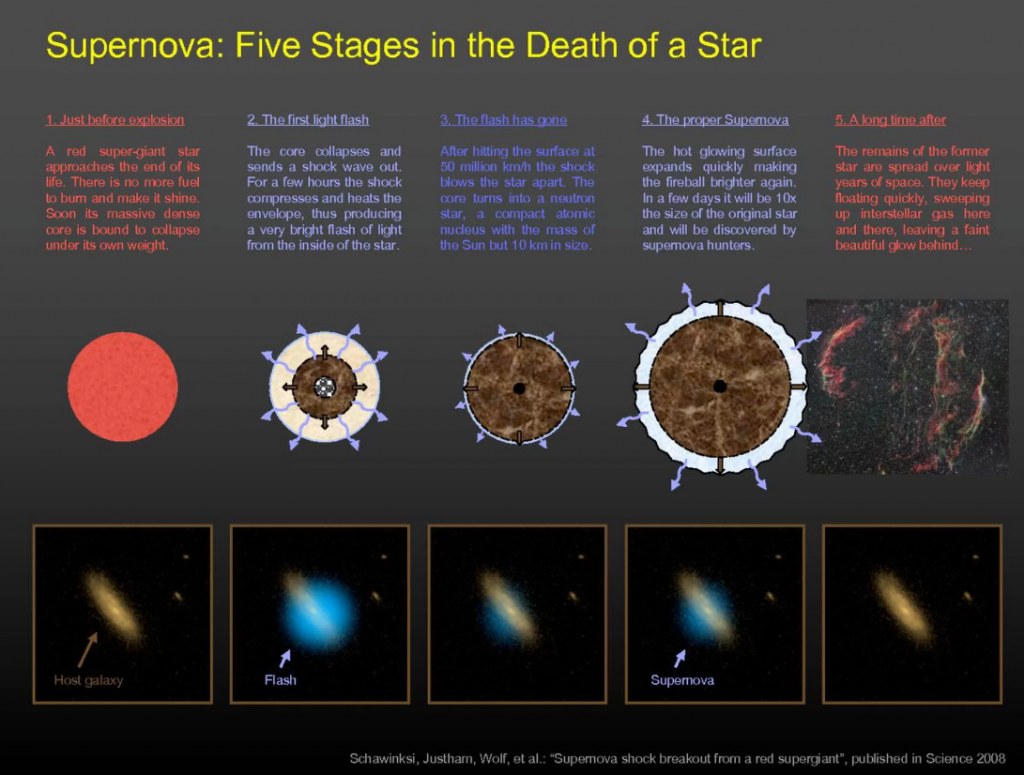One of the most exciting things that an astronomer could possibly see in their line of work has to be a stellar explosion – or in other words a supernova. These fascinating phenomena occur when a big star becomes unstable and as a result explodes, creating a massive blast of light, radiation, and matter. They tend to flare to their brightest within a few days then slowly start to fade away leaving behind a mist of exotic radiation and matter. When these explosions occur, you know about it as they’re brighter than of all stars in the Universe put together. The intense pressures created by the explosion cause atoms to fuse into heavy elements that are used later on down the line in the formation of stars and planets.
All stars must maintain a certain balance in order to survive. The energy that’s produced in the star’s core keeps it from collapsing under its own mass. So if fuel levels in the core get too low fusion ceases and thanks to gravity, the star collapses inwards. If it’s a small star such as our own Sun, the core will simply compress momentarily before returning to its original size. When this happens, the surrounding layers of the star are shed, leaving the core to cool down as a white dwarf. With regards to larger stars, their collapsing cores are compressed even more. Protons and electrons fuse together to form neutrons. For even larger stars, the matter inside the core is so compact that black hole forms. The rest of the star is then expelled violently emitting shock waves of energy as it goes, outshining anything else surrounding it.

The term “Nova” is Latin for new and was determined back in 1572 when a new naked-eye star was discovered in the constellation Cassiopeia by Danish astronomer Tycho Brahe. At the beginning, it was brighter than Venus, until gradually dimming until it eventually disappeared from sight in 1574. Since then astronomers have discovered various more novae and in 1934 Walter Baade and Fritz Zwicky came up with the term “supernova” to differentiate between normal novas and those that were of a much greater magnitude. Sometimes supernovas produce spinning neutron stars that emit beams of energetic radio waves and charged particles that can be detected by radio telescopes. These explosions can also leave black holes.
On average our own Milky Way galaxy is host to one supernova around once a century. One such supernova was discovered recently in the constellation Cygnus by amateur astronomer Patrick Wiggins of Tooele, Utah. It occurred in the outskirts of NGC 6946 (nicknamed the Fireworks Galaxy) which is located about 8 million light-years from Earth. Experts at the Xinglong Station of National Astronomical Observatories of China (NAOC) figure that Wiggins’ supernova is just about to reach its maximum brightness, and when it does, anyone should be able to view it using a backyard telescope that’s of at least a 4-inch aperture. If you’re located in the mid-northern latitude the best time to view the supernova will be around 10 pm when the night sky has set in.
While using a backyard telescope is great, but you only have a window of around a week to view this supernova. By using a detailed sky-charting app like SkySafari 5 you can actually zoom in on the galaxy and compare those stars viewed through the telescope to those shown on the app. Another way to observe these phenomena is by looking at remnants of the supernova that happened within our own galaxy. Although these are merely shells, they still glow brightly due to the ultraviolet radiation that’s generated from inside them. If you’re using the app you also get the added benefit of a wealth of information about these objects at your fingertips as well as the fantastic images.
The Crab Nebula (otherwise known as Messier 1 (M1) is a supernova remnant that was first recorded by Chinese astronomers back in 1054. It appeared four times brighter than Venus and could even be seen in daylight for a period if 23 days. After that, it remained visible in the night sky for a further two years. When looking at the Crab Nebula through a telescope or binoculars it appears as a small fuzzy patch located just 2 degrees from Zeta Tauri, a prominent star of the constellation Taurus. It can be quite challenging trying to view this supernova remnant today as is a lot dimmer now than it was all those years ago.
The Veil Nebula is another supernova remnant, but this one is very different to the Crab Nebula for many reasons. One reason is that at approximately six moons in diameter, it’s huge! But then it has been expanding for the last 5,000 years so it shouldn’t be that surprising to learn. However, the shell has now started to disperse, leaving behind curved sections of veil-like streamers. The Veil Nebula is currently in a great position for viewing and will be there right up until late summer.
More News to Read
- Why Not Use the Moon as A Gas Station to Get to Mars?
- Researchers Discover How to Store Information In Chemicals
- Are These Mini Spherical Reactors the Answer to Fusion Energy’s Problems?
- Scientists Subject Quantum Entanglement to Extreme Levels of Acceleration
- New Monster Mars Rover Looks a Little Scary











